
Chapter 1. Chapter 14: Natural Selection and Adaptation
1.1 Introduction

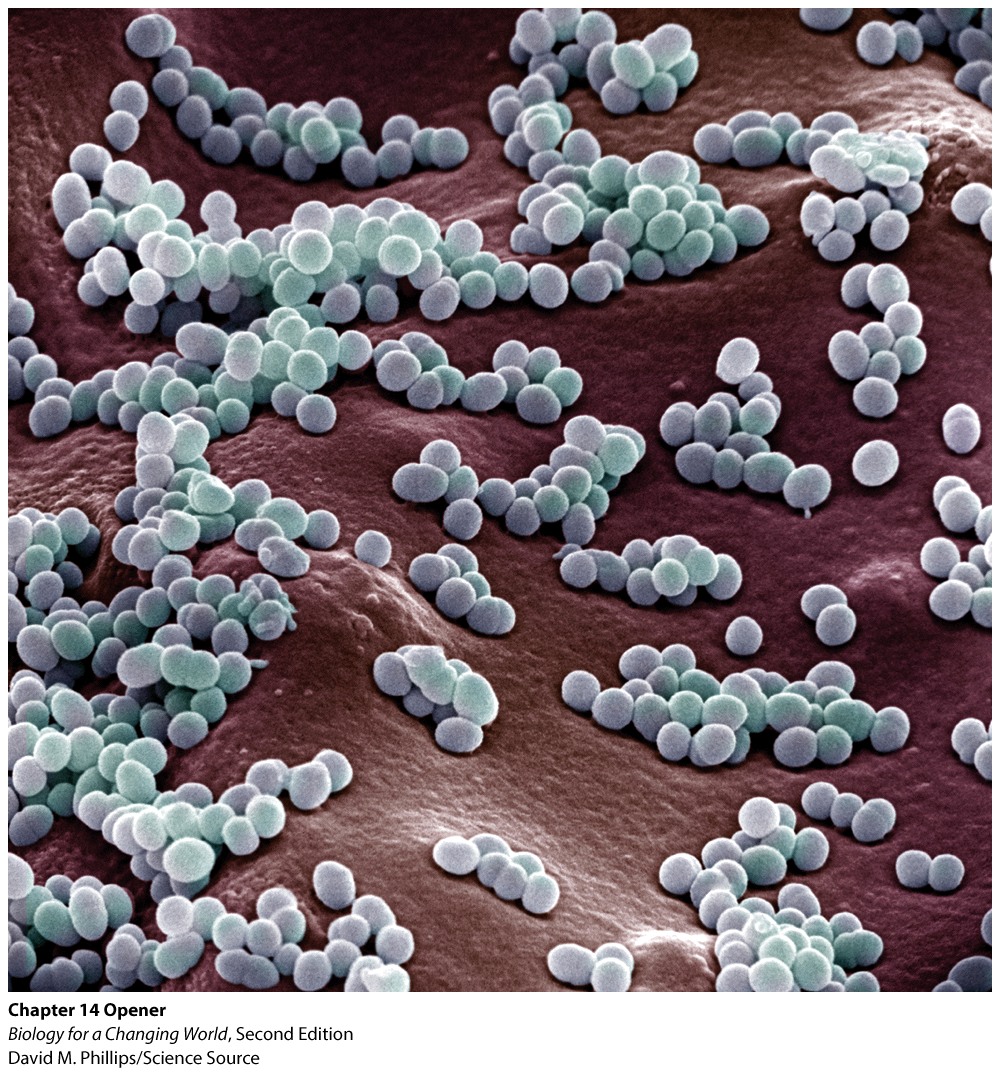
Welcome to the Interactive Study Guide for Chapter 14: Natural Selection and Adaptation! This Study Guide will help you master your understanding of the chapter's Driving Questions, using interactive Infographics and activities, as well as targeted assessment questions. Click "Next" to get started, or select a Driving Question from the drop-down menu to the right.
Bugs that Resist Drugs:
Drug-resistant bacteria are on the rise. Can we stop them?
DRIVING QUESTIONS
- What is staph and can it be present in the absence of an infection?
- How do bacteria resist the effects of antibiotics?
- How do populations evolve and what is the role of evolution in antibiotic resistance?
1.2 Driving Question 1
Driving Question 1
What is staphylococcus and can it be present in the absence of an infection?
Why should you care?
Staphylococcus aureus (commonly called staph) is a common skin bacterium that is easily transmitted from person to person. A strain called Methicillin-Resistant Staphylococcus aureus (MRSA) is becoming increasingly common. This strain is potentially deadly and very difficult to treat.
What should you know?
To fully answer this Driving Question, you should be able to:
- Describe the basic features of the bacterium Staphylococcus aureus (S. aureus) and its modes of transmission.
- Explain why people can harbor S. aureus and not be infected by it.
Infographic Focus
The infographic most pertinent to the Driving Question is 14.1.
Describe the basic features of the bacterium Staphylococcus aureus (S. aureus) and its modes of transmission.
1.
Describe the shape of S. aureus and where it is primarily found on the body.
2.
What types of diseases or problems does S. aureus typically cause?
3.
How is S. aureus transmitted from person to person?
Explain why people can harbor S. aureus and not be infected by it.
4.
S. aureus has been shown to be living on people’s skin and sometimes in their nasal passages. Why are these people not constantly being infected with this potentially deadly bacterium?
Review Questions
5.
Staph is a species of:
| A. |
| B. |
| C. |
| D. |
6.
True or False. If a doctor finds that you have S. aureus living in your nose, it can be asssumed that you will become infected.
| A. |
| B. |
7.
If you harbor S. aureus but do not have an infection, then a person who comes in contact with your particular strain of S. aureus:
| A. |
| B. |
| C. |
| D. |
1.3 Driving Question 2
Driving Question 2
How do bacteria resist the effects of antibiotics?
Why should you care?
Beta-lactams are among the most commonly prescribed antibiotics; you have probably taken them several times yourself. MRSA is resistant to this class of antibiotics.
Ricky Lannetti, Rebecca Lohsen, and Carlos Don died because a bacterium that is normally harmless became resistant to antibiotics. Genetic variability is at the heart of the process that led to that change. Bacteria reproduce asexually through a process called binary fission, so their primary source of genetic variability is mutations that occur during DNA replication. Because bacteria reproduce extremely rapidly, bacterial populations can accumulate mutations rapidly. The more mutations that occur, the greater the chances that one or more of them will be beneficial to the bacteria – and potentially deadly to us. Bacteria can also acquire new genes via direct transfer from other bacteria. As a consequence, once it arises via mutation, a gene for resistance to one or more antibiotics can spread very rapidly through a bacterial population (including a population inside your own body!). This process is key to the problem of widespread antibiotic resistance.
What should you know?
To fully answer this Driving Question, you should be able to:
- Diagram and describe how beta-lactam antibiotics work.
- Outline the steps in bacterial reproduction.
- Discuss the consequences of binary fission for the accumulation of mutations in a bacterial population over time.
- Describe the process of gene swapping/gene transfer.
- Illustrate and describe how binary fission, mutation, and gene swapping/gene transfer interact to create diverse bacterial populations, some of which may acquire resistance to an antibiotic.
Infographic Focus
The infographics most pertinent to the Driving Question are 14.2, 14.3 and 14.4.
Test Your Vocabulary
Choose the correct term for each of the following definitions:
| Term | Definition |
|---|---|
| A type of asexual reproduction in which one parental cell divides into two. | |
| Chemicals that either kill bacteria or slow their growth by interfering with the function of essential bacterial cell structures. |
Describe how beta-lactam antibiotics work.
8.
What is the function of the bacterial cell wall?
9.
Describe the interaction between beta-lactam antibiotics and bacterial cell walls. Write a brief description of the antibiotic’s overall effect.
Outline the steps in bacterial reproduction.
10.
List and describe the steps in bacterial reproduction by labeling the figure that follows.
- A single bacterium elongates and replicates its DNA.
- Next, the cell wall and plasma membrane begin to divide.
- The cell wall and plasma membrane start to form around the divided DNA, effectively bisecting the original bacterium.
- The two daughter cells separate, each with its own cell wall, plasma membrane, and DNA.
Discuss the consequences of binary fission for the accumulation of mutations in a bacterial population over time.
11.
Assume for simplicity’s sake that you are growing a colony of bacteria from a single cell. One mutation occurs during the first cell division and is maintained in the colony during each round of replication. (Multiple bacteria may be dividing and mutating, but only one bacterium is maintained in the colony.) Replication occurs every 20 minutes.
How many cells with the mutation will have accumulated at the end of 1 hour? At the end of 1 day? Explain.
Describe gene transfer.
12.
Besides spontaneous mutations during DNA replication, what is another way bacteria may acquire new genetic information? Does this process require binary fission?
Illustrate and describe how binary fission, mutation, and gene swapping, or gene transfer, interact to create diverse bacterial populations, some of which are resistant to an antibiotic.
13.
In your notebook, beginning with a single bacterial cell, diagram the development of a genetically diverse population of bacteria via binary fission, mutation, and gene transfer.
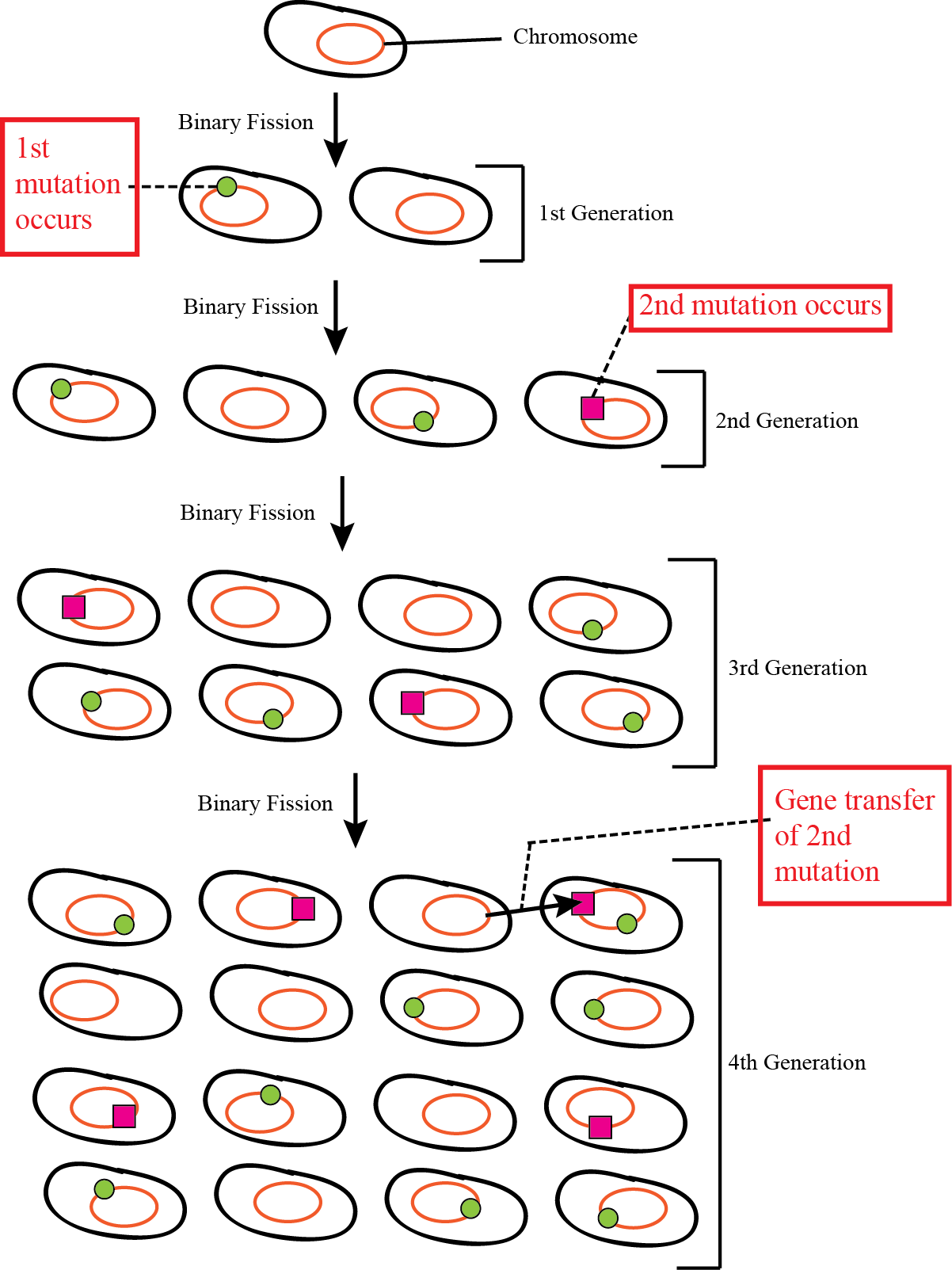
Review Questions
14.
The genetic variation in populations of bacteria comes from:
| A. |
| B. |
| C. |
| D. |
15.
The cell wall is a good target for an antibiotic since eukaryotic cells do not have one. What would be another bacteria-specific target for an antibiotic?
| A. |
| B. |
| C. |
| D. |
1.4 Driving Question 3
Driving Question 3
How do populations evolve, and what is the role of evolution in antibiotic resistance?
Why should you care?
The traits that led to MRSA arose via mutation and gene swapping. The bacterial populations that possess those traits have increased in number, however, because we have created an environment that favors them. The interaction between an organism’s phenotype and its environment determines its fitness – its ability to survive and reproduce relative to other organisms in the same environment. The ways in which we use antibiotics (and antivirals, insecticides, herbicides, etc., for that matter) create the conditions that increase the fitness of organisms resistant to those substances.
Natural selection explains why MRSA has spread. Although several different mechanisms can lead to evolutionary change, natural selection is the only mechanism that leads to adaptation – the accumulation of traits favorable in a particular environment. Understanding adaptation is important for scientists in fields as varied as agriculture, medicine, resource management, and ecology as well as in evolutionary biology. On a more immediate level, understanding the process will help you make better health care decisions!
When we understand the patterns of natural selection, we improve our ability (very limited at present) to predict how a given environmental change – whether it’s the introduction of a new antibiotic or the current pattern of global climate change – might affect us and the plants, animals, and microbes around us. The better we can predict these changes, the better we can manage our health and resources.
MRSA and other forms of antibiotic resistant bacteria pose serious health risks. Fortunately, a few simple steps can reduce your risks.
What should you know?
To fully answer this Driving Question, you should be able to:
- Illustrate and explain the relationship among an organism’s phenotype, environment, and fitness.
- Identify and explain the characteristics of individuals, populations, and the environment that are necessary for natural selection to occur.
- Outline the specific steps of natural selection.
- Describe the relationship between natural selection and evolution.
- Compare and contrast directional, stabilizing, and diversifying selection.
- Give at least one example of each pattern of natural selection.
- List and describe four practices that will help reduce your risk of becoming infected by antibiotic-resistant bacteria.
Infographic Focus
The infographics most pertinent to the Driving Question are 14.4 14.5, 14.6, 14.7 and 14.8.
Test Your Vocabulary
Choose the correct term for each of the following definitions:
| Term | Definition |
|---|---|
| The relative ability of an organism to survive and reproduce in a particular environment. | |
| A type of natural selection in which organisms with phenotypes at one end of a spectrum are favored by the environment. | |
| Differential survival and reproduction of individuals in response to environmental pressure that leads to change in allele frequencies in a population over time. | |
| A type of natural selection in which organisms with phenotypes at both extremes of the phenotypic range are favored by the environment. | |
| Change in allele frequencies in a population over time. | |
| A type of natural selection in which organisms near the middle of the phenotypic range of variation are favored by the environment. | |
| A group of organisms of the same species living together in the same geographic area. | |
| The process by which populations become better suited to their environment as a result of natural selection. |
Illustrate and explain the relationship among an organism’s phenotype, environment, and fitness.
16.
Fill in the table with the appropriate fitness levels to illustrate the interaction between a population’s phenotype and its environment on its fitness:
| Bacterial Phenotype | Fitness in the absence of antibiotic | Fitness in the presence of antibiotic |
| Antibiotic-sensitive |
Fill in below:
A single mutation in a tumor suppressor gene associated with DNA repair.
|
Fill in below:
A single mutation in a tumor suppressor gene associated with DNA repair.
|
| Moderately antibiotic-resistant |
Fill in below:
A single mutation in a tumor suppressor gene associated with DNA repair.
|
Fill in below:
A single mutation in a tumor suppressor gene associated with DNA repair.
|
| Highly antibiotic-resistant |
Fill in below:
A single mutation in a tumor suppressor gene associated with DNA repair.
|
Fill in below:
A single mutation in a tumor suppressor gene associated with DNA repair.
|
17.
Suppose that in a population of flies some individuals carry a mutation making them resistant to the insecticide DDT but reducing the number of offspring they can produce. Flies without the mutation have many offspring but die in the presence of DDT. Draw a table similar to the previous one, substituting “DDT” for “antibiotic” and “fly” for “bacteria.” Fill in the table with the appropriate fitness levels.
| Fly Phenotype | Fitness in the absence of DDT | Fitness in the presence of DDT |
| DDT-sensitive |
Fill in below:
A single mutation in a tumor suppressor gene associated with DNA repair.
|
Fill in below:
A single mutation in a tumor suppressor gene associated with DNA repair.
|
| Moderately DDT-resistant |
Fill in below:
A single mutation in a tumor suppressor gene associated with DNA repair.
|
Fill in below:
A single mutation in a tumor suppressor gene associated with DNA repair.
|
| Highly DDT-resistant |
Fill in below:
A single mutation in a tumor suppressor gene associated with DNA repair.
|
Fill in below:
A single mutation in a tumor suppressor gene associated with DNA repair.
|
18.
In your own words, describe the relationship among an organism’s phenotype, its environment, and its fitness.
Identify and explain the characteristics of individuals, populations, and the environment that are necessary for natural selection to occur.
19.
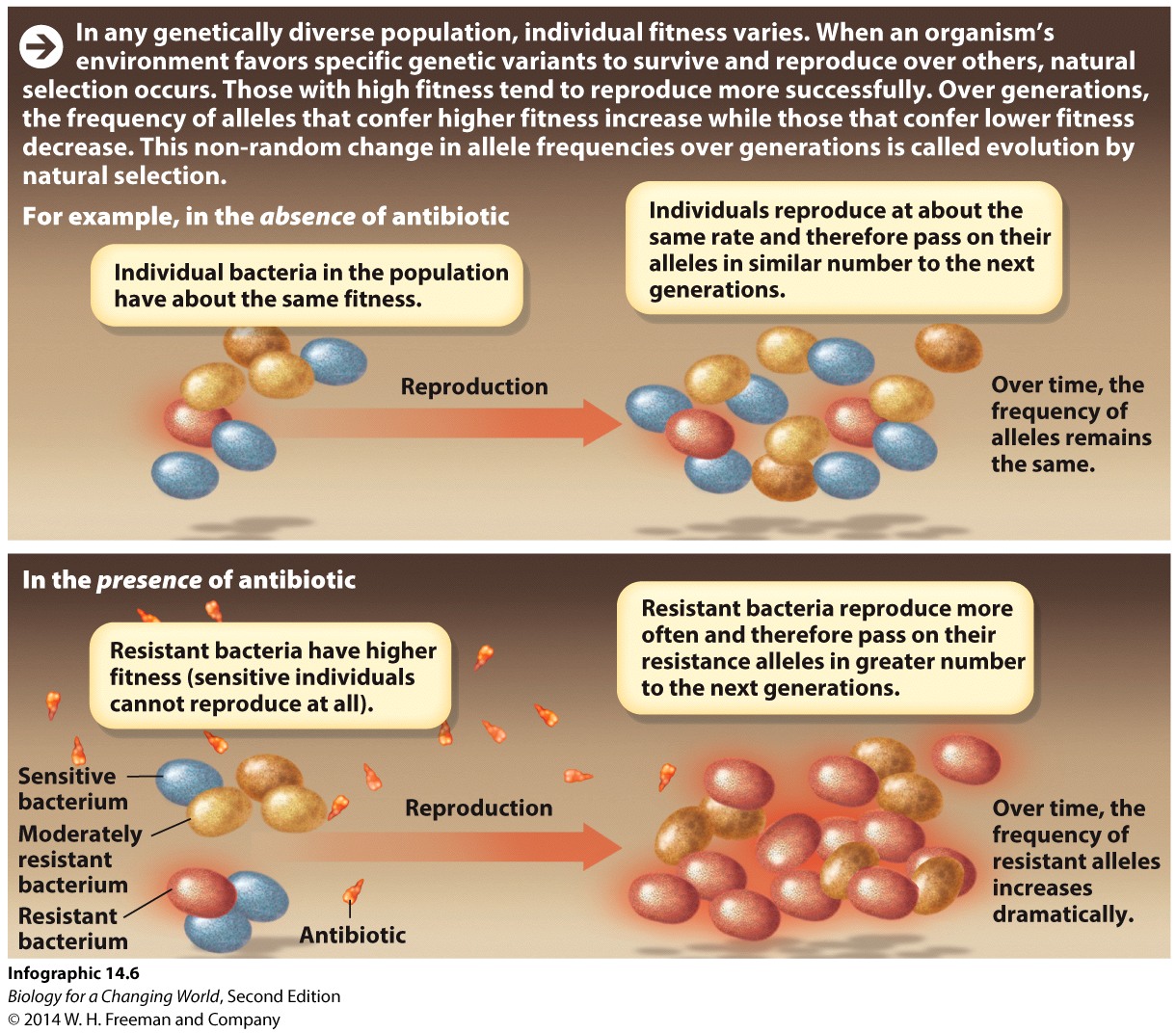
Examine the top figure in Infographic 14.6 and answer these questions:
Is the original bacterial population genetically uniform or genetically diverse?
20.
What is the environment for these bacteria?
21.
In that environment, do any individual bacteria have a survival or reproductive advantage over others?
22.
Does the frequency of alleles and phenotypes in this population change over time?
23.

Examine the bottom figure in Infographic 14.6 and answer these questions:
Is the original bacterial population genetically uniform or genetically diverse?
24.
What is the environment for these bacteria?
25.
In that environment, do any individual bacteria have a survival or reproductive advantage over others?
26.
Does the frequency of alleles and phenotypes in this population change over time?
27.
Based on your answers, can evolution by natural selection occur in the absence of genetic variation? Will it take place any time genetic variation occurs? Explain.
28.
Based on your answers, can evolution by natural selection occur in the absence of differences in fitness among individuals in the population? Explain.
29.
Based on your answers, what determines whether fitness varies among individuals (and if it occurs, which traits will be favored)?
Outline the specific steps of natural selection.
30.

A population of birds consists of individuals exhibiting a range of bill sizes. Under normal conditions, most individuals find sufficient food in the form of seeds to survive and reproduce at about the same rate. During prolonged droughts, however, smaller seeds are consumed rapidly, leaving larger, harder seeds as the primary food source. Birds with larger bills are better able to crack and eat these seeds than are birds with smaller bills.
In your notebook, diagram the future of such a population under normal conditions and under drought conditions, using a structure similar to that in Infographic 14.6. Describe each of the steps you illustrate and explain any differences in the outcomes you would expect to see.
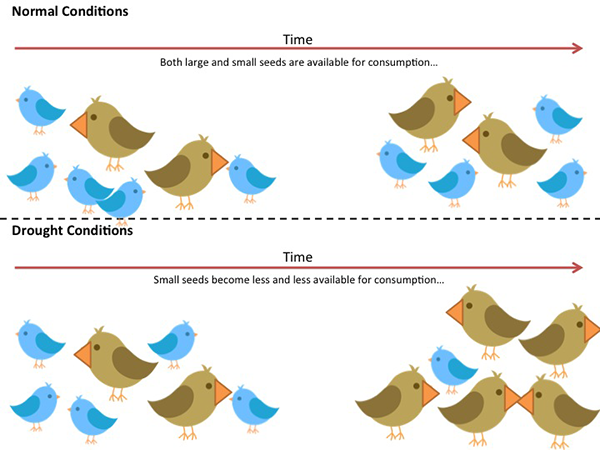
Under normal conditions, the food supply would remain stable with both large and small seeds to eat. Thus, the frequency of small-beaked birds to large-beaked birds would remain stable as well (there would be no major change).
Under drought conditions, small seeds would be eaten rapidly leaving mainly large seeds for consumption. Since the small-beaked birds cannot eat the large seeds, they would die off in the population resulting in a lowered frequency of small-beaked birds to large-beaked birds
Describe the relationship between natural selection and evolution.
31.
A small population of endangered beetles lives in a habitat so isolated that no other members of the species can immigrate. Most individuals in the population are brown, black, and green, and a few individuals are brown, black, and blue. Not all beetles can find enough food to reproduce every year. One year, by chance, none of the brown, black, and blue individuals are able to reproduce, leaving a population of only black, brown, and green individuals.
Has evolution occurred in this population? Explain.
32.
Has natural selection occurred in this population? Explain.
33.
Based on your answers, explain in your own words the relationship between natural selection and evolution.
Compare and contrast directional, stabilizing, and diversifying selection.
34.
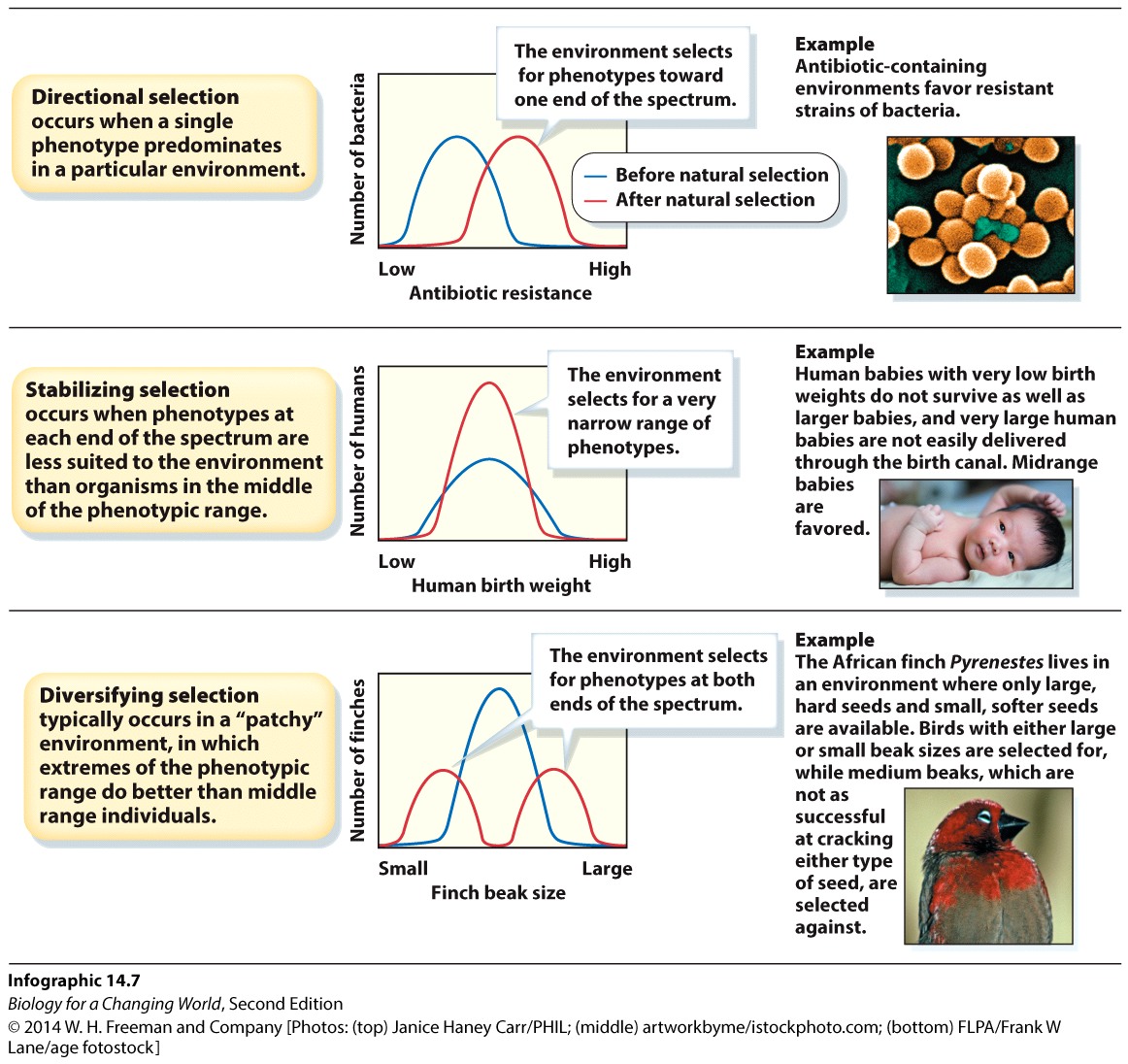
Examine Infographic 14.7.
What, if anything, do these three patterns have in common?
35.
How, if at all, do these patterns differ from one another?
Give at least one example of each pattern of natural selection.
36.
List and briefly describe one example of each pattern of natural selection from your text.
• Stabilizing selection: human birth weight
• Diversifying selection: beak size of the African finch
37.
Make up at least one example of each type of selection using hypothetical organisms, phenotypes and environmental conditions.
• Stabilizing selection: a bird population's migratory path leads them through a tunnel of a certain diameter filled with spider webs. Only the birds that are small enough to fit through the tunnel yet large enough to break free of the spider webs will survive.
• Diversifying selection: a population of stiff noodle neck turtles has three main phenotypes. Those with long necks eat the berries off tall trees. Those with medium necks eat the berries off shrubs. Those with short necks eat the berries off the ground. Since the stiff noodle neck turtle cannot bend its neck, it relies on the berries found where it can reach them. If a ground fire affecting only medium to short foliage spreads through the forest, the surviving phenotypes of turtles would be tall neck and short neck.
List and describe four mechanisms for reducing your risk of becoming infected by antibiotic-resistant bacteria.
38.
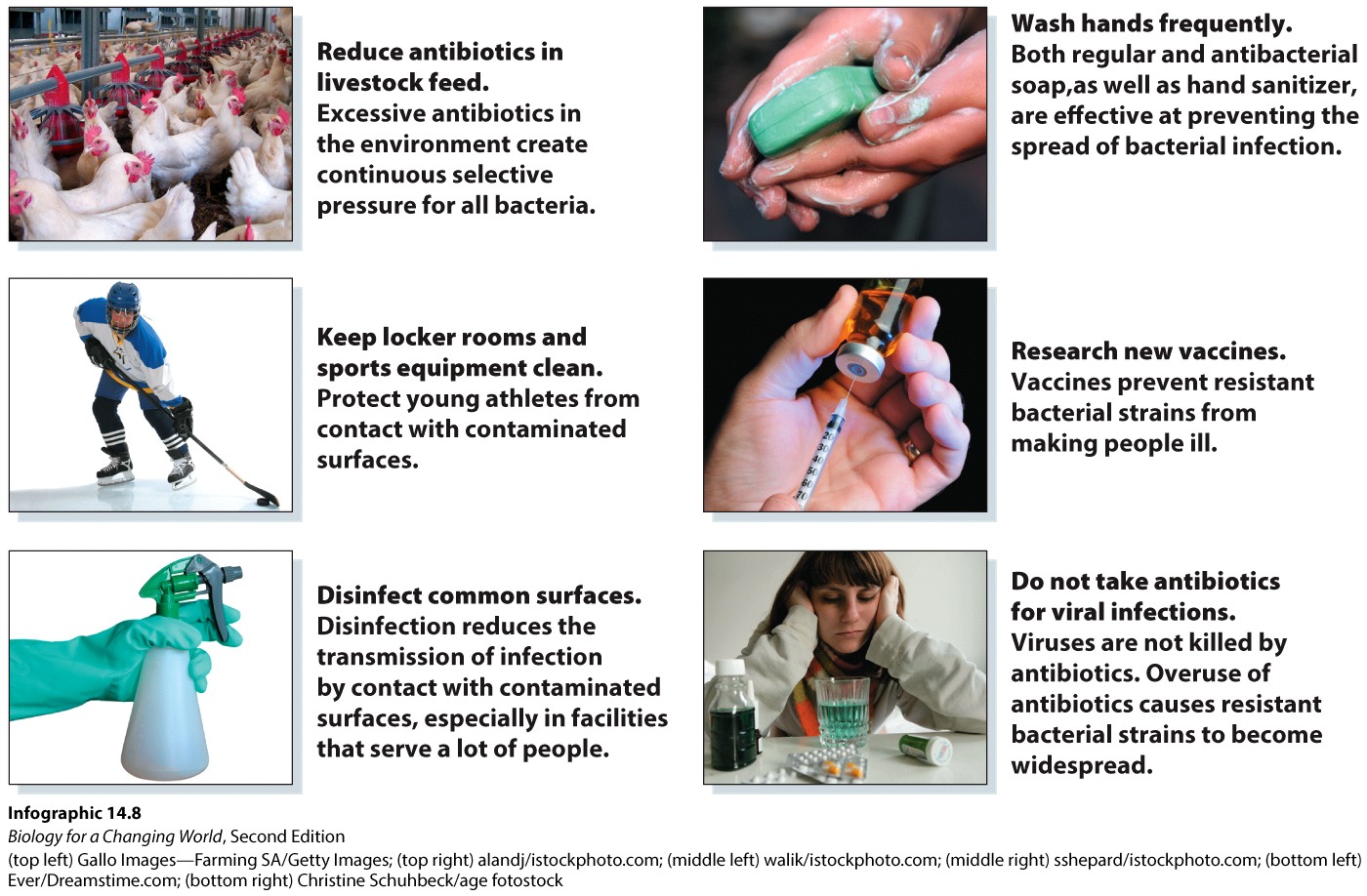
Explain how among the practices illustrated in Infographic 14.8, four of them help you reduce your risk of becoming infected by antibiotic-resistant bacteria.
• Wash hands with regular soap; this reduces spread of antibiotic-resistant bacteria and self-infection.
• Get vaccinated; this prevents you from becoming ill with certain strains of antibiotic-resistant bacteria.
• Do not take needless antibiotics; if you have a viral infection, do not take antibiotics, which will needlessly expose your commensal bacteria to the drug and thus introduce selection pressure to the populations.
Thought Question: Why is the increasing bacterial resistance to antibiotics a bad thing?
Review Questions
39.
True or False. Natural selection causes individuals to change their allele frequencies.
| A. |
| B. |
40.
For a change of fitness to occur, there must be a:
| A. |
| B. |
| C. |
| D. |
41.
In stabilizing selection, the genetic diversity of the population typically:
| A. |
| B. |
| C. |
42.
True or False. Always take antibiotics prescribed by your doctor, no matter what organism, viral or bacterial, is causing your illness.
| A. |
| B. |
Activity results are being submitted...